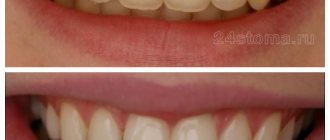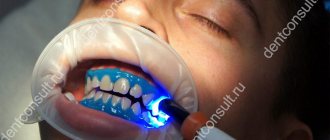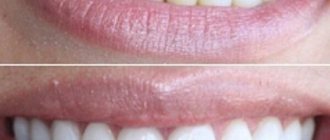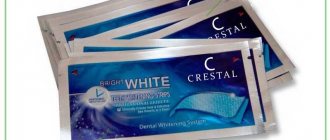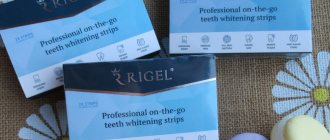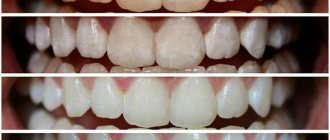Dr. Kizim
>
Articles
>
Teeth whitening: how long does the effect last?
The desire for white teeth of a perfectly even color is a natural desire of many patients who visit the dentist. Indeed, despite all efforts, even non-smoking and non-coffee-drinking patients are not always able to maintain white teeth. There is also such a factor as heredity, and here it will be difficult to argue with nature. However, it is always possible to make your teeth several shades lighter; another question is how long the teeth whitening lasts.
What is in-office teeth whitening
In-office teeth whitening is an aesthetic dental procedure that takes place in a doctor’s office under his full supervision. An important advantage of this method over home whitening is absolute safety, fast and effective results. You can get the desired result even in one procedure, while teeth whitening at home will take several weeks. Anesthesia is not required, as there is no pain during the process.
Contraindications to teeth whitening
Doctors recommend completely abandoning the procedure or postponing it indefinitely during pregnancy and breastfeeding, as well as when:
- individual intolerance to the components of the whitening composition;
- the presence of a milk bite that has not changed to a permanent one;
- oncology;
- increased sensitivity of enamel;
- tissue damage due to traumatic exposure or other reasons;
- pulpitis in chronic form;
- orthodontic treatment;
- dental diseases (for example, caries) in the acute phase;
- a large number of fillings, fixed dentures, artificial crowns (possible color balance disturbances, unnatural whiteness of certain areas).
Each case is reviewed by a dentist; the doctor may prohibit lightening of the teeth to avoid adverse reactions. Why do you need teeth whitening if it will lead to irreversible consequences? It is likely that the presence of the above circumstances is not an absolute obstacle to a cosmetic procedure, and in the absence of dangerous risks it can be completed.
Types of in-office whitening
Photobleaching
A gel is applied to the teeth, which is activated by light from a halogen or ultraviolet lamp. The gel contains peroxide, which decomposes into water and oxygen. It is thanks to the effect of oxygen that dark pigments from tooth tissue are discolored, creating a whitening effect.
Pros:
- high efficiency;
- quickly achieving the desired result;
- safety;
- painlessness.
Flaws:
- relatively high cost.
Chemical bleaching
The essence of the procedure is to apply two mixed gels to the surface of the teeth. As a result, a chemical reaction occurs that leads to discoloration of dark pigment spots in the dental tissues. The concentration of active substances is higher than with other types of whitening, which can cause a temporary increase in tooth sensitivity.
Pros:
- safety;
- high whitening speed.
Minuses:
- dental hypersensitivity is present for 1-2 days;
- the whiteness effect is not as pronounced as with photobleaching.
The Saint-Dent Clinic in Moscow provides all types of dental treatment. American and European equipment is used in their work; doctors have extensive experience and regularly improve their knowledge and skills through courses in the best foreign dental centers. You can find the clinic's contacts here. The section with current prices is posted here
Briefly about the types of whitening
Modern dentistry offers options with which you can lighten the enamel up to 10–12 tones. Let's list them:
| Whitening method | Peculiarities | How many shades does the enamel lighten? | Time spent in the dentist's chair |
| Laser | The most expensive, but one of the most effective methods that can eliminate even the unpleasant yellow tint of “tetracycline” teeth | 10–12 tones | About an hour |
| Photobleaching | A gel is applied to the enamel, which is then activated using ultraviolet, halogen or LED lamps. Within this method, popular technologies are ZOOM, Amazing White, Luma-Arch, Beyond Polus | 6–12 tones | 45–60 minutes. The gel is applied up to 6 times in a row in several approaches (10–15 minutes each) |
| Chemical | Activation of bleaching components is carried out using chemical reagents. Quite an aggressive technique, but affordable. One of the most popular technologies today is Opalescence | 4–5 tones | From 15 to 60 minutes |
| Cosmetic Magic White | A relatively new and very inexpensive method. The creators claim that the procedure is so simple that it does not require a professional dentist, and all manipulations can be easily performed by a cosmetologist. | For 4–121 tones | From 20 to 60 minutes |
Helpful advice! If you are for naturalness and just want your teeth to look well-groomed and natural, then do professional hygiene with Air-Flow and ultrasound instead of whitening. This is the most gentle and safe way. During the procedure, the doctor will remove all types of plaque and deposits localized on the teeth, gums and under them. A nice bonus is that the enamel is lightened by 1-2 tones.
Advantages and disadvantages of the procedure
Advantages:
- achieving a good aesthetic result in just one session;
- with proper technological execution, the procedure is absolutely safe;
- within a week the patient will be able to return to their normal lifestyle.
Flaws:
- tooth sensitivity to hot and cold foods increases;
- there is a risk of thinning the enamel;
- the gums and mucous membrane of the tongue may become inflamed;
- in a few years the procedure will have to be repeated again.
How is whitening different from professional teeth cleaning?
Professional oral hygiene is the mechanical removal of pigment, plaque, and deposits from the surface of tooth enamel. At the same time, the teeth retain their natural shade. Whitening is a chemical process that removes pigmentation inside the tooth, in the enamel and dentin. In this case, the tooth changes its color to whiter. Before whitening, you need to have clean teeth, so you will have to undergo professional oral hygiene before the whitening procedure.
Indications and contraindications
Indications:
- dark or severely discolored teeth;
- partial or complete internal darkening of teeth;
- presence of fluorous spots;
- age-related changes in tooth color.
Contraindications:
- numerous carious cavities;
- the presence of an exposed neck of the tooth;
- cracks and chips on the enamel surface;
- increased abrasion of enamel;
- enamel erosion or its partial absence;
- periodontal disease;
- allergic reactions to one of the components included in the gel;
- oral diseases.
It is important to know. Restorative materials and crowns cannot be bleached, so after completion of the procedure it is necessary to re-do the restoration. It can be performed no earlier than 2 weeks after in-office whitening.
How long will the whiteness last if you do home whitening?
Whitening brushes and pastes
Those who use such products may be disappointed, since the effect often lasts only during the period of use. But you cannot use such products constantly - breaks are necessary, otherwise there is a risk of injury and severely weakening the enamel.
On a note! Do not overuse whitening pastes with a high level of abrasiveness (from 100 to 200 RDA). They are capable of lightening the enamel by 1-2 tones, no more, but their frequent or daily use literally wears away the teeth, making them very sensitive, thin, susceptible to erosion and caries. Use such pastes no more than 1-2 times a week.
There are pastes that only “promise” to whiten the enamel, but in fact they only create a reflective film on the teeth, making it seem as if the enamel has become lighter and acquired a beautiful shine. As soon as you stop using the product, everything will return to normal.
Strips and gels for home use
The strips are coated with a composition containing carbamide peroxide; various gels also contain this whitening component. The content of the active substance in products for home use is minimal, due to which teeth can be lightened, at best, by 3-4 tones. And the result will remain in the absence of measures to maintain it for no longer than 2-3 months. With good oral care, the effect of a snow-white smile can be extended up to 6–12 months, but no more.
Folk remedies
Salt and soda, activated carbon, lemon - all these are strong natural abrasives. They are able to remove soft pigmented plaque, due to which the enamel becomes lighter by 1-2 tones. If used carelessly (for example, if you press hard on the brush or rub the products on the enamel), they remove not only plaque, but at the same time the top layer of the enamel itself.
The result lasts on average for 1-2 weeks or a month if you thoroughly cleanse the oral cavity of food debris, plaque and bacteria, and also adhere to a diet that does not contain foods and drinks with bright coloring pigments.
What directly determines the duration of the whitening effect?
- individual characteristics of the patient and the original natural color of the enamel,
- the chosen method of lightening and the number of shades by which teeth were whitened,
- thorough oral hygiene care,
- presence of bad habits, in particular smoking,
- dietary habits after the procedure.
The essence of the in-office whitening procedure
The dentist performs the following actions:
- applies protection to the oral mucosa;
- applies the whitening agent to the frontal area of the teeth;
- when photobleaching, I expose the gel to light from a halogen or ultraviolet lamp;
- after a certain time (on average 15 minutes), the drug is washed off with plenty of water;
- At the end of the procedure, the teeth are coated with a special gel that reduces their sensitivity.
Good to know. Along with the darkened areas of the teeth, useful minerals are removed. The lack of substances can be compensated for by remineralization of teeth.
Types of teeth whitening: pros and cons
There are no ideal lightening methods. Each has positive and negative sides that the patient must be prepared for. This is why you need to consult your dentist first.
Mouthguards
These are removable devices that are made of special materials that are not subject to oxidative processes. As a rule, structures are used to correct bites and change the position of teeth. If the mouth guard is installed correctly, it does not cause discomfort (pain or other discomfort). After the adaptation period, the patient completely forgets about the presence of a foreign object in the mouth.
The device is created from an impression, which the dentist first makes during the initial appointment. The finished structure is filled with a whitening agent and placed on the upper or lower jaw.
Advantages:
- low cost compared to other methods;
- Possibility of teeth whitening at home.
Flaws:
- insufficient visual effect, mouth guards will not get rid of intense yellowish deposits;
- risk of developing an allergic reaction;
- The method is contraindicated for persons with orthodontic structures in the mouth (plates, braces, etc.).
Laser technique
This method is one of the most effective. You can walk with a snow-white smile for up to 10 years, of course, if you do not ignore medical instructions. In this case, the enamel becomes white in just one session.
A gel composition is applied to the teeth, after which its components are activated using a laser, oxygen ions are formed, which penetrate the enamel layer and deactivate the coloring pigment.
Pros:
- To lighten by more than 5 tones, one visit to the clinic is enough;
- absence of pain and other discomfort;
- the device operates for a short time (about 20 minutes);
- the gel used has antiseptic properties and prevents inflammatory processes in the mouth;
- the components of the drug strengthen the enamel and protect it from external influences.
Negative sides:
- high price compared to alternative methods;
- increased tooth sensitivity immediately after the procedure.
Ultrasonic cleaning
In this case, enamel lightening occurs due to the removal of hard plaque and other deposits, even in the interdental spaces. With the help of vibrations, all layers are mechanically removed. After all the manipulations, the specialist applies a special paste-like composition to the teeth to improve the protection of the dentition from external influences and various chemical irritants.
Ultrasound helps to get rid of even subgingival plaque. The stone is also removed.
Pros:
- in one visit to the dentist you can lighten your teeth several shades;
- during the procedure, the entire oral cavity is cleaned, and not just hard tissues;
- absence of pain and other unpleasant sensations;
- affordable price.
Minuses:
- To consolidate the effect, ultrasonic cleaning should be repeated annually;
- the result may seem insufficient if the enamel is too dark;
- the natural shade of dentin tissue does not change;
- A visit to the doctor takes up to an hour.
Chemical bleaching
The dentist applies highly concentrated preparations that contain hydrogen peroxide or other active ingredients. As a result, dentin is whitened, its shade becomes lighter by 5-7 tones or more.
Advantages of the method:
- an effective procedure that removes plaque and lightens the dentinal layer;
- if all manipulations were performed according to the rules, the result can last up to 4-5 years.
Minuses:
- increased sensitivity of enamel after lightening;
- high price;
- the risk of burns to the mucous membranes if the dosage regimen of the chemical composition is not followed;
- It takes many procedures (about 7) at intervals of 2-3 days to achieve the desired effect.
Air Flow
The surface of the teeth is processed mechanically, without affecting the dentinal layer. The doctor uses a sandblasting machine for this. Even the most difficult to reach areas (for example, interdental spaces) will be clean after exposure to a mixture of water, air and soda. The enamel is polished and the smile becomes dazzling.
Advantages:
- absence of pain and other discomfort;
- the entire oral cavity is cleansed, including the space between the teeth, under the gums, etc.;
- fabrics are not damaged, abrasive particles act very gently;
- the patient is not bothered by increased tooth sensitivity immediately after brushing;
- affordable price.
Minuses:
- insufficiently expressed visual effect;
- a greater number of contraindications compared to alternative methods;
- the color lasts up to a year.
Photobleaching
One of the most modern techniques with ZOOM or Luma-Arch devices. The enamel brightens due to ultraviolet exposure. The lamp warms up the lightening gel applied to the teeth, thereby enhancing its effect.
Pros:
- the procedure lasts about 15 minutes;
- per visit you can make the enamel 10 shades lighter;
- the effect lasts up to 4 years if you follow the rules established by your doctor and adhere to basic hygiene standards;
- absence of pain syndrome.
Minuses:
- high cost (methods involving mechanical cleansing will be much cheaper);
- It is advisable to completely exclude foods with bright dyes from the diet;
- subsequent remineralization may be required;
- before photobleaching, it is necessary to remove microprostheses and veneers;
- bleaching is uneven, hard-to-reach areas are not lightened, but only the front incisors and canines;
- If the procedure technique is not followed, the risk of burns to the mucous membranes of the oral cavity increases.
Endobleaching
This technique is also called in-canal bleaching. This method is used when depulpation has been performed, that is, removal of palpable tissue. After the death of the nerve, the teeth darken, so many patients want to lighten them.
The doctor pours a special synthetic composition with a whitening effect into the cavity and places a temporary filling material on top. If the enamel becomes lighter within 10-15 days, the drug is removed and everything is filled.
Advantages:
- you can lighten one or several teeth at once;
- the enamel remains intact because the whitening agent acts from the inside.
Flaws:
- short-term effect (up to a year);
- not suitable for processing both rows;
- the price increases as the number of teeth treated increases.
Home whitening
Not all patients want to visit a dental clinic and prefer to whiten their enamel at home. The most common procedures:
- The use of special whitening pastes. Typically, such compositions contain abrasives, affecting the entire surface of the dentition. As a result, it is possible to lighten the enamel layer by several tones.
- Special stripes. They resemble a plaster and are glued to the incisors of the upper and lower jaws. The adhesive side contains a gel with concentrated chemical compounds. An oxidation process takes place in the mouth, which promotes quick and easy cleansing.
- Traditional methods. Fans of “grandmother’s” recipes use hydrogen peroxide, soda, activated carbon and other substances.
What are the advantages of self-lightening at home:
- low price;
- ease of implementation.
The list of disadvantages is much more extensive than the list of advantages. This:
- low effectiveness compared to professional care;
- negative impact on enamel, damage to the mucous membranes of the oral cavity, the appearance of hypersensitivity to any irritant;
- high risk of allergies and poisoning due to careless use and, as a result, ingestion of bleaching mixtures.
How long does the procedure take?
While the patient is in the dental chair, the doctor constantly monitors his condition and the color of the teeth being whitened. One session consists of 1-3 whitening procedures of 15 minutes each. If during the session the patient experiences any unpleasant sensations, he must notify the specialist about this. If necessary, the procedure can be repeated after a few days.
How much can you whiten your teeth with this type of whitening?
Changes before and after in-office whitening will be noticeable immediately. After chemical whitening, teeth become lighter by 6-8 tones, and after photo-whitening – by 8-12 tones.
What you need to know before the procedure
Teeth whitening is a fairly effective procedure, and many patients manage to achieve the desired effect: the teeth become noticeably lighter by several shades, which cannot be ignored after the whitening is completed. However, not all patients know that the effect of such a procedure is temporary and it is impossible to know exactly how long teeth whitening lasts. Unfortunately, even with the current level of science, it is not possible to achieve lifelong whitening of teeth. After some time, the patient will have to contact the doctors again and repeat the procedure.
When teeth whitening, how long the effect lasts depends on which parts of the tooth are being whitened. During the procedure, chemical reagents only affect living tooth tissue, and whitening will only take place in this area. That is, the installed fillings simply will not stain and will not change their gray color. Therefore, before bleaching, doctors place the lightest types of dental fillings , which will differ minimally from the bleached surface.
How long does the effect last and how often should the procedure be done?
The resulting effect lasts for 2-7 years. The duration of the result depends on the type of whitening chosen, the individual characteristics of the person and his lifestyle. Teeth whitening can be repeated at least after 1-2 years.
To ensure that the whitening effect lasts as long as possible, you must follow these recommendations:
- maintain oral hygiene;
- to refuse from bad habits;
- limit the consumption of coloring foods and drinks (you should completely avoid them in the first 7 days);
- Visit a hygienist every six months for professional oral cleaning.
Things to remember before any whitening procedure
- If you want the effect to be maximum, then before the procedure it is necessary to carry out professional cleaning. During the process, the specialist will prepare the teeth: remove plaque, make the surface even, smooth and susceptible to further exposure to lightening agents. Whitening can be carried out no earlier than 7–14 days after professional hygiene - during this time the enamel and gums will be restored.
- Two weeks before the session, it is necessary to begin strengthening the enamel with pastes with fluoride or calcium, and undergo a course of remotherapy or fluoridation. It is important to diversify the menu and add to the diet all groups of vitamins and microelements that are beneficial for teeth and gums - B, C, E, D, K, calcium, fluorine, phosphorus, iron, zinc. The lack of vitamins in food can be compensated with vitamin-mineral complexes.
- It is necessary to cure caries and all damaged teeth, stop the inflammatory process on the mucous membrane, if any.
- Immediately before the procedure, you need to eat, because after it it is not recommended to do this for 2-3 hours.
But you can change artificial crowns and old fillings only after whitening. Remember that composites and other materials (such as ceramics) cannot be lightened. The previous color of the structures will remain, and it is unknown whether it will match the new shade of your enamel.
Important! Not all teeth can be whitened. It will not be possible to achieve significant success if the enamel and the underlying dentin are naturally gray in color. Professional (and especially home) methods will not cope with severe fluorosis2 and hypoplasia. For the listed pathologies, it is better to choose an alternative - veneers or lumineers, crowns.
Daytime home teeth whitening
For people who are not willing to experience some discomfort from wearing aligners at night, there is a daytime teeth whitening program. The main parameters of this procedure are very similar to the program described above. The main difference between daytime teeth whitening is the schedule of procedures. Daytime wearing of aligners is shorter - an hour on the upper jaw and an hour on the lower jaw. Another condition is a feeling of pressure on your teeth. This is a guarantee of active penetration of the drug into the tooth enamel, and, as a result, the key to the high efficiency of the whitening procedure.
How long should I keep the dental strips on?
Depending on the manufacturer and composition of the product, whitening strips must be left on for 5 to 30 minutes. At this time, under no circumstances should you smoke, eat, drink, or even sleep with stripes on your teeth. During the entire whitening course, it is not recommended to eat foods that stain the enamel.
If you strictly follow the instructions, the whitening procedure will be high-quality and effective; if not, problems with your gums and teeth are possible. That is why, before choosing and using whitening strips, it is recommended to consult with your doctor!
How do you know what color you will get after bleaching?
We know that teeth with a yellow tint can be whitened very well. Teeth with a gray or gray-blue tint, as well as teeth with tetracycline staining (discoloration of teeth due to taking the antibiotic tetracycline), fluorosis (a chronic disease that develops with prolonged ingestion of water or products with a high content of fluoride compounds), are difficult to whiten. hypoplasia (insufficient development of enamel). The results of whitening are affected by the age of the patient and the reason for the staining of the teeth.
What is this procedure?
The name of the Zoom 4 procedure comes from the name of the system used to whiten tooth enamel. The Zoom system was developed in the United States, gained worldwide recognition and became widely used in other countries. Zoom 4 is the latest version of this system, allowing you to whiten your teeth without damaging the enamel. Its main advantage is an improved light source (LED) and three light output power modes, thanks to which the problem of dental hypersensitivity during and after the procedure has now been solved.
Stages of the Zoom 4 teeth whitening procedure:
- the dentist determines the most optimal shade of enamel using the Vita Scale;
- protect eyes with special glasses;
- a special cream is applied to the patient’s lips and cheeks, and a paste is applied to the gums, which hardens upon contact with air;
- teeth in the “smile zone” (10 lower and 10 upper front teeth) are coated with a whitening agent;
- the Zoom 4 lamp is used to treat the dentition;
- the remaining active ingredients are removed.
